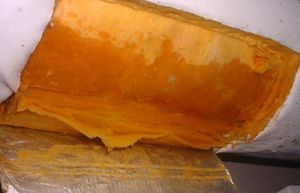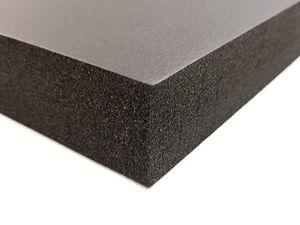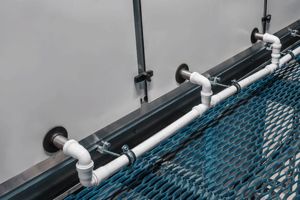 When fiberglass insulation gets wet, the North American Insulation Manufacturers Association (NAIMA) recommends that it be removed and thrown out as soon as possible to prevent mold and fungi growth. When properly installed and maintained, elastomeric foam is an extremely effective deterrent to biological contamination, condensation, and moisture ingress. Unlike fiber-based products, which have been found to hold moisture for longer than two weeks, closed-cell elastomeric foam won’t absorb moisture. Its smooth surface also inhibits the accumulation of dirt that serves as a food source for mold. Even if closed-cell foam duct liner gets wet, its smooth surface makes it extremely easy to clean and maintain.
When fiberglass insulation gets wet, the North American Insulation Manufacturers Association (NAIMA) recommends that it be removed and thrown out as soon as possible to prevent mold and fungi growth. When properly installed and maintained, elastomeric foam is an extremely effective deterrent to biological contamination, condensation, and moisture ingress. Unlike fiber-based products, which have been found to hold moisture for longer than two weeks, closed-cell elastomeric foam won’t absorb moisture. Its smooth surface also inhibits the accumulation of dirt that serves as a food source for mold. Even if closed-cell foam duct liner gets wet, its smooth surface makes it extremely easy to clean and maintain.
Moisture needn’t be a problem in a well-designed and maintained HVAC system. The following preventative measures will help eliminate moisture problems and minimize the risk of mold or mildew.
- Fully insulate all cold-water pipes, fittings, tanks, and condensate drain lines with closed-cell elastomeric foam material like AP/ArmaFlex.
- Avoid gaps or unsealed seams by sealing all joins and seams with one of our high performance contact adhesives.
 Use insulation materials that have non-moisture-absorbing properties – especially on refrigeration piping where condensation is a concern.
Use insulation materials that have non-moisture-absorbing properties – especially on refrigeration piping where condensation is a concern.- Fully insulate cold-air supply ducts and air-handling equipment with closed-cell elastomeric foam material like AP/ArmaFlex.
- Use an insulation thickness calculator like ArmaWin™ to determine the adequate insulation thickness to control condensation. Condensation control typically requires greater insulation thickness than thermal efficiency.
- Carefully monitor indoor relative humidity, keeping RH at 60% or below.
 Design systems with adequate drainage in mind. This means installing equipment at appropriate pitch for proper drainage, as well as providing easy access to drain pans to check for water more often.
Design systems with adequate drainage in mind. This means installing equipment at appropriate pitch for proper drainage, as well as providing easy access to drain pans to check for water more often.- Change filters regularly and inspect for any accumulation of dirt, moisture, or mold.
- Clean and inspect air handlers annually and clean ducts every 5 to 10 years. In certain climates and environments, cleaning may be required more often. 1https://insulationinstitute.org/wp-content/uploads/2016/02/BI483.pdf
- Seal cooling ducts during the heating season to prevent moisture from accumulating. Dampers are not airtight and therefore should be sealed by taping plastic sheeting over them.
